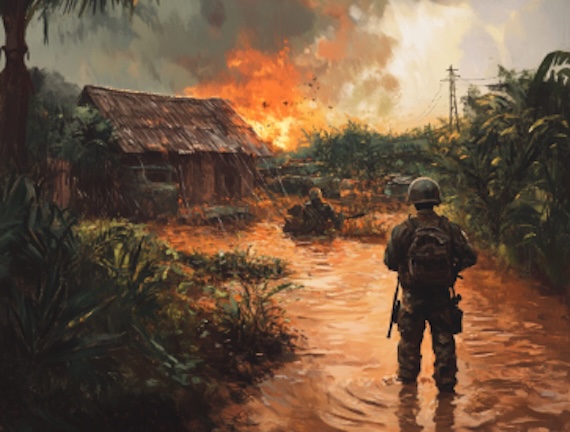Vancouver (Special to Informed Comment; Feature) – I am writing this essay on the 50th anniversary of the liberation of Vietnam from the genocidal war that the United States inflicted on this Southeast Asian country (and Laos and Cambodia) for three decades.
The story begins in 1887 with French colonialism established over most of Indochina. The primary goal, of course, was access to cheap resources and labor to enrich the elites back home. After the First World War, a young Vietnamese named Ho Chi Minh petitioned the Paris peace conference for the self-determination and independence for the Vietnamese people. He was ignored.
French rule was interrupted by Japanese imperialism in 1940, when they seized control of Vietnam. In response, Ho Chi Minh helped to establish the the major anti-colonial movement, the Viet Minh. They worked with the United States to resist Japanese rule. When the war ended, Ho was hoping to continue the positive relationship with Washington, but the U.S. was more interested in helping the French to reestablish their colonial rule. Their attempt to assert control over Vietnam (and Indochina) let to a savage war, in which Washington ended up providing about 80% of the financing for France.
In spite of that, the Vietnamese resistance was so effective that France was forced to give up after their defeat at the battle of Dien Bien Phu in 1954.
However, U.S. President Dwight Eisenhower refused to accept the Vietnamese victory, warning that it would create a “domino” effect that would encourage other countries to turn “communist”. In reality, the main fear was that other nations would demand independence from the U.S. sphere of political and economic control.
However, the 1954 Geneva Peace Accord stated that the French forces would move to the southern part of the country while the Vietnam forces would move to the northern part of Vietnam. There would be a national election in 1956 to re-unify the country. The United States ignored the treaty, because, as Eisenhower himself admitted, in a free election, “80 per cent of the populations would have voted for the Communist Ho Chi Minh as their leader…”
Instead, the U.S. established a puppet government in the city of Saigon, led by the Catholic Ngo Dinh Diem (who had been residing in the U.S.) Diem soon began a terrorist campaign to eliminate any opposition to his rule, which, over the next few years, turned into a mass movement that led to the formation of the National Liberation Front (NLF) as the political wing of the anti-government insurgency.
From that point on, the war escalated as the U.S. sent more troops and helicopters to assist Diem, and in 1962, they began spraying Agent Orange and other herbicides over rural areas of South Vietnam to kill vegetation that would offer cover and food for guerrilla forces.
(There is some evidence that President John F. Kennedy was planning to withdraw U.S. troops if he was re-elected in 1964, but after his assassination, President Lyndon Johnson dramatically escalated American involvement).
In 1965, the U.S. government manufactured a fake North Vietnamese attack in the Gulf of Tonkin as an excuse to send hundreds of thousands of U.S. troops to fight the Vietnamese, while increasing the bombing of the entire country to levels even greater than in the Second World War.
By 1967, more than 500,000 U.S. troops were stationed in Vietnam.
In 1968, the Vietnamese resistance launched their “Tet Offensive, which not only demonstrated how powerful these “Viet Cong” forces were, but resulted in journalist Walter Cronkite (“the most trusted man in America”), to publicly call for an end to the war. At the same time, the demand for peace was growing as millions of Americans took to the streets to demand an end to the slaughter.

“My Lai,” Digital, Midjourney, 2025
Also in 1968, U.S. forces carried out their infamous massacre at My Lai, where more than 500 civilians were murdered. (Note: the massacre ended only when a U.S. helicopter crew, led by Major Hugh Thompson, put themselves in between the Vietnamese and U.S. forces and ordered them to stop).
Around this time, President Johnson asked his generals if sending another 200,000 troops would defeat the Vietnamese. He was told that it might not be enough, but that they were needed at home as protests against the war escalated.
When Richard Nixon was elected in 1968, he said that he had a secret plan to end the war. White House tapes that were released during his Watergate scandal revealed that he and his advisor, Henry Kissinger were planning to use nuclear weapons against the Vietnamese – but decided not too only because of the terrible backlash that would erupt, not just in the United States but around the world.
On the other hand, as Daniel Ellsberg revealed when he released the Pentagon Papers, the major reason why the U.S. continued the war was because Washington feared a loss of international prestige if it admitted defeat. In fact, as Nixon was forced to begin the partial withdrawal of U.S. troops, the bombing escalated and the war spread to neighboring Laos and Cambodia.
By the time the war finally ended in 1975, over 3 million people were killed, millions more wounded, and millions suffered from such tactics as the poisonous chemical Agent Orange, land mines, and so on.
On the other hand, the U.S. military-industrial complex, such as Lockheed Martin, Boeing, and General Dynamics made literally hundreds of billions of dollars, as well as companies like Dow Chemical and Monsanto, which profited from the sale of Agent Orange and other chemicals.
Lest we forget.


 © 2025 All Rights Reserved
© 2025 All Rights Reserved